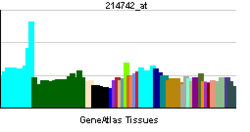- AZI1
-
5-azacytidine induced 1 Identifiers Symbols AZI1; AZ1; Cep131; ZA1 External IDs OMIM: 613479 MGI: 107440 HomoloGene: 7638 GeneCards: AZI1 Gene Gene Ontology Molecular function • molecular_function Cellular component • cytoplasm
• centrosome
• centrosome
• cytosol
• microtubule cytoskeleton
• intracellular membrane-bounded organelleBiological process • G2/M transition of mitotic cell cycle
• mitotic cell cycle
• multicellular organismal development
• spermatogenesis
• biological_process
• cell differentiationSources: Amigo / QuickGO RNA expression pattern 
More reference expression data Orthologs Species Human Mouse Entrez 22994 12009 Ensembl ENSG00000141577 ENSMUSG00000039781 UniProt Q9UPN4 Q62036 RefSeq (mRNA) NM_001009811.2 NM_009734.3 RefSeq (protein) NP_001009811.2 NP_033864.3 Location (UCSC) Chr 17:
79.16 – 79.2 MbChr 11:
119.93 – 119.95 MbPubMed search [1] [2] 5-azacytidine-induced protein 1 is a protein that in humans is encoded by the AZI1 gene.[1][2][3][4]
References
- ^ Kikuno R, Nagase T, Ishikawa K, Hirosawa M, Miyajima N, Tanaka A, Kotani H, Nomura N, Ohara O (Oct 1999). "Prediction of the coding sequences of unidentified human genes. XIV. The complete sequences of 100 new cDNA clones from brain which code for large proteins in vitro". DNA Res 6 (3): 197–205. doi:10.1093/dnares/6.3.197. PMID 10470851.
- ^ Aoto H, Miyake Y, Nakamura M, Tajima S (Jun 1997). "Genomic organization of the mouse AZ1 gene that encodes the protein localized to preacrosomes of spermatids". Genomics 40 (1): 138–41. doi:10.1006/geno.1996.4546. PMID 9070930.
- ^ Andersen JS, Wilkinson CJ, Mayor T, Mortensen P, Nigg EA, Mann M (Dec 2003). "Proteomic characterization of the human centrosome by protein correlation profiling". Nature 426 (6966): 570–4. doi:10.1038/nature02166. PMID 14654843.
- ^ "Entrez Gene: AZI1 5-azacytidine induced 1". http://www.ncbi.nlm.nih.gov/sites/entrez?Db=gene&Cmd=ShowDetailView&TermToSearch=22994.
Further reading
- Aoto H, Tsuchida J, Nishina Y, et al. (1996). "Isolation of a novel cDNA that encodes a protein localized to the pre-acrosome region of spermatids.". Eur. J. Biochem. 234 (1): 8–15. doi:10.1111/j.1432-1033.1995.008_c.x. PMID 8529672.
- Bonaldo MF, Lennon G, Soares MB (1997). "Normalization and subtraction: two approaches to facilitate gene discovery.". Genome Res. 6 (9): 791–806. doi:10.1101/gr.6.9.791. PMID 8889548.
- Strausberg RL, Feingold EA, Grouse LH, et al. (2003). "Generation and initial analysis of more than 15,000 full-length human and mouse cDNA sequences.". Proc. Natl. Acad. Sci. U.S.A. 99 (26): 16899–903. doi:10.1073/pnas.242603899. PMC 139241. PMID 12477932. http://www.pubmedcentral.nih.gov/articlerender.fcgi?tool=pmcentrez&artid=139241.
- Gerhard DS, Wagner L, Feingold EA, et al. (2004). "The status, quality, and expansion of the NIH full-length cDNA project: the Mammalian Gene Collection (MGC).". Genome Res. 14 (10B): 2121–7. doi:10.1101/gr.2596504. PMC 528928. PMID 15489334. http://www.pubmedcentral.nih.gov/articlerender.fcgi?tool=pmcentrez&artid=528928.
- Beausoleil SA, Villén J, Gerber SA, et al. (2006). "A probability-based approach for high-throughput protein phosphorylation analysis and site localization.". Nat. Biotechnol. 24 (10): 1285–92. doi:10.1038/nbt1240. PMID 16964243.
- Olsen JV, Blagoev B, Gnad F, et al. (2006). "Global, in vivo, and site-specific phosphorylation dynamics in signaling networks.". Cell 127 (3): 635–48. doi:10.1016/j.cell.2006.09.026. PMID 17081983.
Categories:- Human proteins
- Chromosome 17 gene stubs
Wikimedia Foundation. 2010.
